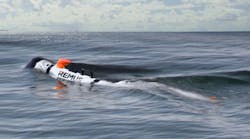Officials of the Naval Air Systems Command at Patuxent River Naval Air Station, Md., announced a $532.6 million contract Friday to the General Atomics Electromagnetic Systems Group in San Diego to provide the Electromagnetic Aircraft Launch System (EMALS) for the future aircraft carrier USS Enterprise (CVN 80), which is to be commissioned in 2025.
General Atomics also is providing EMALS for the first two Ford-class aircraft carriers, the USS Gerald Ford (CVN 78) and the USS John F. Kennedy (CVN 79). The Ford, which is to be commissioned this year, will replace the retired USS Enterprise (CVN 65). The Kennedy, to be commissioned in 2020, will replace the USS Nimitz (CVN 68), and the Enterprise will replace the USS Dwight D. Eisenhower (CVN 69).
EMALS uses electric power, rather than steam power, to launch Navy aircraft off the decks of aircraft carriers. Steam provided launch power on all carriers up to the Ford class. EMALS uses a linear motor drive instead of steam pistons for launching aircraft.
Related: High-power electronics at the heart of electromagnetic carrier launch and recovery systems
EMALS will reduce reduces stress on aircraft because it accelerates them more gradually to takeoff speed than steam-powered catapults. EMALS also is more efficient, smaller, lighter in weight, more powerful, and easier to control than are steam-powered catapults. The General Atomics EMALS shipset has thousands of pieces of hardware.
The Ford-class carriers also will use the Advanced Arresting Gear (AAG), also built by General Atomics. The AAG uses electric motors, rather than hydraulics, to stop aircraft landing aboard aircraft carriers.
EMALS originally had some technical problems in development, but completed its test program last year. EMALS was cited as one of the systems causing delays in delivery of the USS Ford to the Navy.
Although steam-powered catapults and hydraulic arresting gear are reliable, they represent technologies that are at last half a century old. Aircraft carrier steam catapults are large, heavy, inefficient, and difficult to control. Their biggest drawback is they not suitable for launching and recovering unmanned aerial vehicles (UAVs).
Related: X-47B combat drone launches from aircraft carrier in milestone maritime UAV demonstration
The General Atomics EMALS and AAG systems are different. Electromagnetic technology is far more efficient than steam catapults, and offer much finer control such that they can launch heavy manned aircraft, yet have enough control to launch light manned aircraft and UAVs.
Electromagnetic technology in the AAG system helps absorb the energy of landing aircraft with turboelectric engines, rather than hydraulics, which makes catching the arresting cable with the tail hook smoother with reduced shock on aircraft of all types.
On Friday's contract General Atomics will do the work in San Diego; Mankato, Minn.; Tupelo, Miss.; Cincinnati; Boston; New Milford, Conn.; Green Bay, Wis.; Lisbon, N.H.; Randolf, N.J.; East Mckeesport, Pa.; Orange, Calif.; Oceanside, Calif.; Franklin, Mass.; Stuttgart, Germany; Elk Grove Village, Ill.; Las Vegas; Rome, N.Y.; Manson, Ohio; Irvine, Calif.; Allen Texas; Livonia Mich.; and Grant Pass, Ore., and should be finished by September 2027.
For more information contact General Atomics Electromagnetic Systems online at www.ga.com/ems, or Naval Air Systems Command at www.navair.navy.mil.
Learn more: search the Aerospace & Defense Buyer's Guide for companies, new products, press releases, and videos



